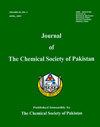A New Approach to Hydrogen Sulfide Removal
IF 0.5
4区 化学
Q4 CHEMISTRY, MULTIDISCIPLINARY
Journal of the chemical society of pakistan
Pub Date : 2022-01-01
DOI:10.52568/000980/jcsp/44.01.2022
引用次数: 3
Abstract
Many separation processes are used to capture of hydrogen sulfide. Which of these techniques to choose depends on the location of the gas. Conventional gas cleaning processes have significant disadvantages such as considerable energy, maintenance costs and environmental concerns. Compared to conventional processes, membranes are light and compact and have a lower environmental impact, higher energy efficiency and ease of use. Although some rubber and glassy polymer membranes have been used for gas separation, there is an opportunity to reach a much larger potential market with newer and better membranes. In this study, H2S was captured with copper chloride in the polymeric membrane. Copper chloride was added to the polymeric membrane by mechanical mixing. The present study had two main objectives. First, a water-based membrane was prepared, and its characterization was done. Second, a pilot experimental apparatus was built for hydrogen desulfurization. Next, the capture of hydrogen sulfide with the membrane was tested in a pilot experimental apparatus. This study highlights that a new model membrane can utilize the hydrogen sulfur capture performance. FeS, iron (II) sulfide, and dilute HCl were used to obtain hydrogen sulfide in this study. The property of the membrane to hold H2S gas was examined with the amount of gas released by passing the H2S gas through the membrane. SEM-EDS analysis confirmed the accumulation of copper and H2S on the membrane surface. Also, no clogging and contamination problems were observed. The membrane retains its hydrophilic property even after use. The results obtained in the experimental study showed that the newly produced membrane captured 100 percent of H2S. The main object in this study, a new approach to H2S capture. The new copper loaden membrane tested in this study has successfully removed H2S and is expected to be a promising alternative to conventional desulphurization processes.脱除硫化氢的新方法
许多分离过程用于捕获硫化氢。选择哪一种技术取决于气体的位置。传统的气体清洗工艺有明显的缺点,如相当大的能源,维护成本和环境问题。与传统工艺相比,膜轻巧紧凑,对环境的影响更小,能源效率更高,使用方便。虽然一些橡胶和玻璃聚合物膜已用于气体分离,但有机会达到一个更大的潜在市场的更新和更好的膜。在本研究中,H2S被聚合膜中的氯化铜捕获。采用机械混合的方法将氯化铜加入到聚合膜中。本研究有两个主要目的。首先,制备了水基膜,并对其进行了表征。其次,建立了氢脱硫中试装置。接下来,在一个试点实验装置中测试了该膜对硫化氢的捕获。本研究强调了一种新型膜可以利用氢硫捕获性能。本研究采用FeS、硫化铁(II)和稀盐酸制备硫化氢。通过H2S气体通过膜时释放的气体量来检测膜的容纳H2S气体的性能。SEM-EDS分析证实了铜和H2S在膜表面的积累。此外,没有观察到堵塞和污染问题。这种膜在使用后仍保持其亲水性。实验研究结果表明,新制备的膜捕获了100%的H2S。本研究的主要目标是一种新的H2S捕获方法。本研究中测试的新型铜负载膜成功地去除了H2S,有望成为传统脱硫工艺的一种有前途的替代方法。
本文章由计算机程序翻译,如有差异,请以英文原文为准。
求助全文
约1分钟内获得全文
求助全文
来源期刊
CiteScore
1.30
自引率
14.30%
发文量
41
审稿时长
3.4 months
期刊介绍:
This journal covers different research areas in the field of Chemistry. These include; Analytical Chemistry, Applied Chemistry, Biochemistry, Environmental Chemistry, Industrial Chemistry, Inorganic Chemistry, Organic Chemistry and Physical Chemistry. The journal publishes full length articles and Reviews from researchers in academia in addition to featuring comments. Chemical Research presents short, concise and critical articles offering easy-to-read overviews of basic research and applications in all areas of chemistry.

 求助内容:
求助内容: 应助结果提醒方式:
应助结果提醒方式:


